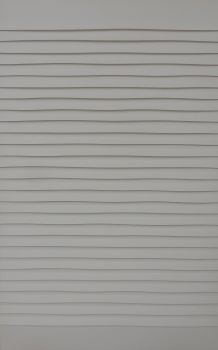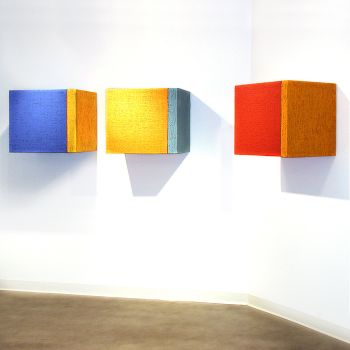Emile Circkens: a forgotten artist
For many decades, Emile Circkens’s work remained hidden from the public within the 'Dienst voor ‘s Rijks Verspreide Kunstwerken' storage facilities and in a dusty Amsterdam attic. Recently rediscovered, many of his works are now for sale at Bert Kuipers Kunsthandel in Enschede. With this article we would like to look back on the life and works of Emile Circkens and commemorate him as a phenomenal artist.

A first glance at Emile Circkens work
A first glance at an artwork by Emile Circkens might leave you with an unexpected feeling. The regularity of what is displayed – folded paper, carefully drawn lines, small squares in series and strips with incisions, all enclosed within a transparent box – looks a little boring.
The differences in pixels are so small that they don't resonate and hardly evoke any excitement. One look and you’ve seen it all.
But when you turn away something strange happens. You are overcome by a sensation of nostalgia, a longing for that which you just encountered, even though it did not appear to be much at first sight.
Upon your return to the object, you notice that the light is now entering the small spaces differently and that the contours of the shapes have translated themselves into new shadows on the back plane.
Structures without a formal hierarchy and a whole that only a moment ago looked like a meaningless sum of its parts are presenting themselves as entities now, even though nothing about the object has changed.
Suddenly you start noticing small and human imperfections in what you thought was industrially manufactured, revealing a manual production process and somehow personifying the object.

Emile Circkens developing his own style
Emile Circkens had a lot to catch up on when he arrived at De Oranje in Rotterdam in 1946, having just been repatriated from former Dutch-India, currently known as Indonesia.
He immediately devoted himself to the cold, post-war artistic climate of the Netherlands that payed little attention to its fellow countrymen from overseas territories. After roaming around for a while he ended up in Amsterdam to train as a decorator.
Through independent studying, visiting museums and receiving lessons from Friso ten Holt he educated himself to become an artist in his own right.
As was the case with many post-war painters, he went through an expressive and informal stage during the early 1960’s. Contrary to Armando, Van Bohemen and Schoonhoven however, who all banned the autobiographical from their material, Circkens’s experiments were reminiscent of his time spent in Indonesia.
‘Burnt Landscape’ for example, a large black painting on which the contours of mountains have been thickly laid on with paint, a reddish glow was added to the background. This red colour hints at the Japanese occupation and the Bersiap.
A comparison to Armando’s 1962 black painting with barbed wire is inevitable.
 Aflopend horizontaal reliëf by Emile Circkens
Aflopend horizontaal reliëf by Emile Circkens
Even though he was completely immersed within his art, his war-experiences began to play their part. On his quest for a definitive form, Circkens moves from black to white, to zero and to new ways of self-expression.
In 1974, during the run-up to total abstraction, he creates a piece clinically titled ‘Structure Reflex’ (bottom image). The viewer is exposed to something that most resembles a model of a new residential area. Neat lines of houses, as seen from the top, with dormer windows through which a reddish-pink light shines out.
Indonesian chaos enclosed by Dutch order, tranquility and regularity. The work speaks for itself, a large sheet of paper, folded to form strips and then stuck to a piece of wood, displaying hinged and half-open hatches. Peepholes.
As soon as the light that hits the object changes, different series of shadows fall onto the slanting rooftops. The work facilitates the movement of light, space and time. Neither the depiction nor the presentation are decisive, it is the aspect of facilitation that forms the punch.
Emile Circkens and 'the light becoming the architect of the soul'
The making of ‘Structure Reflex’ must have been a healing experience for the time being. Such a meticulous process demands a neutral mind which provided a temporary remedy for an increasingly manifesting post-traumatic stress disorder, something which ironically is defined by its own serial aspects.
It brought the artists to spend hours, night after night, locking the front door, closing the windows, turning off the gas supply and then checking everything obsessively. Returning to zero each time, only to start off every new day with folding white paper and Perspex. Gone was the silence.

The influence of the war on Emile Circkens's work
Emile Circkens was born in 1924 in Surabaya. As early as in elementary school it became apparent that he was interested in nothing other than drawing. His father was less happy about his artistic aspirations.
He pleaded for a decent education, but the outbreak of the war ruled out that possibility as well. The family narrowly evaded the cruel Japanese camps because they didn’t carry the Dutch nationality.
They became known as part of the "outside camp". This group walked around freely during the occupation but was robbed of all its sources of income and therefore often fell victim to gruesome Japanese arbitrariness.
The family survived on their savings and on-the-go trading. Their home was frequently searched and the family was often bothered by Japanese visitors to the nearby brothel. At one point, Emile Circkens witnessed the Kempeitai throwing his neighbour’s dead body over the fence into their backyard.

That fear turned into a fear of life after the Japanese capitulation, when Indonesian insurgents and gangs randomly invaded the homes of the "outside campers" to wreak havoc whilst shouting "Bersiap!" (be prepared!).
The Circkens family also fell victim to this violent and senseless rancor. Following a raid and, amongst others, having to run the gauntlet, the young Emile ended up in the notorious Kalisosok prison on Surabaya’s Werfstraat.
A few weeks later he was freed by a Ghurka’s unit from the British army through a lightning action that narrowly managed to prevent the insurgents from burning down the prison.
As soon as life returned to normal it became abundantly clear that the family’s future did not lie in Indonesia. They returned to the Netherlands to move on, unsuspecting of the ghosts from the past that would continue to visit Emile during his lifetime.

Emile Circkens in his last years
Despite compulsive neuroses and increasing fears that forced him further into isolation, Emile Circkens’s art attracted many buyers from galleries and exhibitions. To name one, the AMC medical center in Amsterdam has added numerous works by his hand to their collection.
Unfortunately, this honourable recognition couldn’t prevent the artist from eventually having to rely on the BKR (a Dutch governmental benefit especially for artists) to continue his artistic practices.
He stopped receiving the benefits in 1985 when his weak mental and physical state made it impossible for him to produce any more work, no longer able to meet his ‘personal sales quantum’. Inversely proportional to this, his quantum of psychosocial misery increased.
Until his death in 1997 – during the New Year’s Eve festivities – Emile Cickens lived an anonymous life with his wife and child, forgotten as an artist.
For more available works of Emile Circkens at Gallerease, please have look here!































